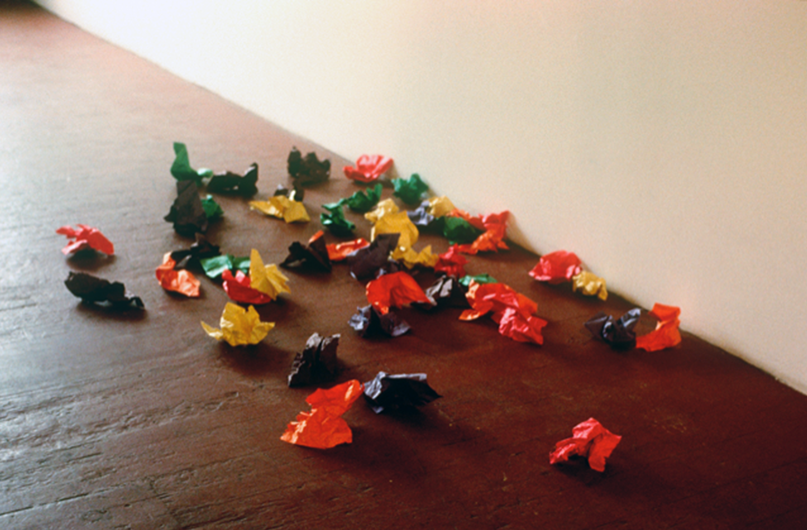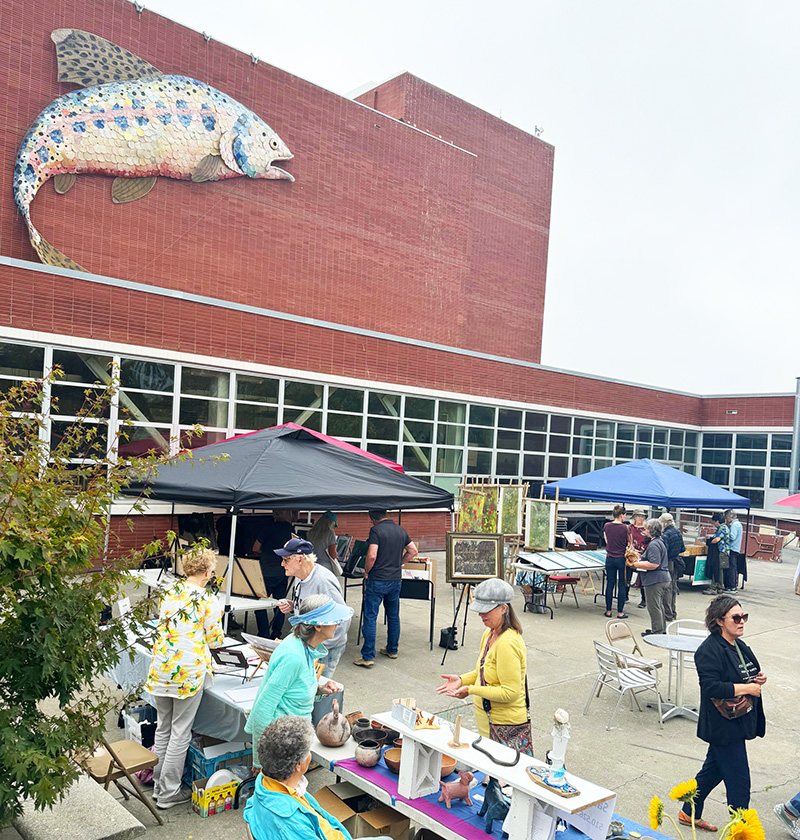By Shaelyn Hanes
Tom Marioni is a San Francisco-based artist, curator, and writer who played a key role in Bay Area conceptual art in the 1970s—a movement in which artists used humor and action to intertwine art and daily life. Marioni moved to San Francisco from Cincinnati in 1959. His first major foray into the San Francisco art scene occurred nine years later, when he became curator at the Richmond Art Center.
From 1968 to 1971, Marioni presented exhibitions at the Richmond Art Center that challenged traditional notions of art. Exhibitions such as The Return of Abstract Expressionism centered Marioni’s artist peers—a group that made ephemeral artwork that centered movement—and placed them into dialogue with art historical figures. Other exhibitions, such as Invisible Painting and Sculpture, demonstrated these artists’ move away from object-based artworks and towards art practices that prioritized space and ideas. While Marioni’s exhibitions at the Richmond Art Center are now celebrated as defining moments in Bay Area art history, they were controversial and challenging for audiences in the 1970s. As a result, Marioni was dismissed from his job at the Richmond Art Center in 1971 after the opening reception of California Girls. The exhibition, which marked the end of Marioni’s tenure at the Richmond Art Center, presented artwork by women living in California and included early works from the feminist art movement.
Independent curator Shaelyn Hanes interviewed Marioni in April 2021 to reflect on his time at the Richmond Art Center and consider the 50th anniversary of California Girls.
SHAELYN HANES: What was the Richmond Art Center known for when you became curator in 1968?
TOM MARIONI: The Richmond Art Center was founded by a woman named Hazel Salmi in 1936. It was one of the most forward-looking galleries in the Bay Area. In the 1950s, it showed the Bay Area Figurative artists. In the 1960s, it showed the Funk artists. When I became curator at the Richmond Art Center in 1968, I wanted to carry on that tradition. That’s when conceptual art was born, so that’s what I showed. Conceptual art wasn’t the majority of what I did, but those were the things that got noticed because they were controversial and underground.
HANES: The Richmond Art Center gained a lot of recognition for those exhibitions, right?
MARIONI: I curated an exhibition called Invisible Painting and Sculpture in 1969. It was the first time Larry Bell, an important leader of L.A.’s Space and Light movement, was seen in the Bay Area. The exhibition didn’t get reviewed in the [San Francisco Chronicle] newspaper, so I wrote a letter to the editor and the art critic. I explained the concept and argued that Invisible Painting and Sculpture was an important show. After that, the editor decided to pay more attention to the Richmond Art Center. That was when [Bay Area art historian and critic] Thomas Albright became an art critic. Albright didn’t drive, so he’d take the bus to the Richmond Art Center. At first, he was critical of the shows I did, like The Return of Abstract Expressionism. It took a long time for him to come around to conceptual art, as it did for most of the Bay Area.
HANES: How did working as a curator inform your practice as a sculptor? Did curating play a role in your move towards the social artworks [staged events in which the artist controls the environment and/or participants] that you made in the 1970s?
MARIONI: When I moved to San Francisco in 1959, I was a minimalist sculptor. San Francisco was expressionistic and figurative. I was doing work that looked like it came out of L.A., where the style was clean and plastic. After hanging shows at the Richmond Art Center, my sculpture expanded to focus on installation instead of single objects. I became a conceptual artist around 1968 when I learned of Joseph Beuys’s idea of social sculpture [the concept that everything in life is art and anyone can be an artist]. The work that I’m most known for, The Act of Drinking Beer with Friends is the Highest Form of Art (1970), is like an opening reception. Receptions are like parties. I always thought the alcohol was an aid to communication. It gets everybody to loosen up.
HANES: What about the logistics of working as both an artist and a curator? I know you worked under a pseudonym for a while.
MARIONI: When I did Invisible Painting and Sculpture, I produced a catalog that listed the artists alphabetically. I included myself in the catalog by inserting two blank pages where my name would have been. That was the first time I included myself as an artist in an exhibition. When I was organizing the next show, The Return of Abstract Expressionism, I selected mostly wall pieces. I needed something on the floor, so I created Birds in Flight (1969). For that piece, I sent instructions to throw crumpled paper on the floor to myself, the curator, from someone named Allan Fish. I made artwork under the name Allan Fish for the next three years while I was curator at the Richmond Art Center. It was a conflict of interest to be an artist and a curator, especially if you put yourself in the show. I exposed it in 1971 after I left the Richmond Art Center.
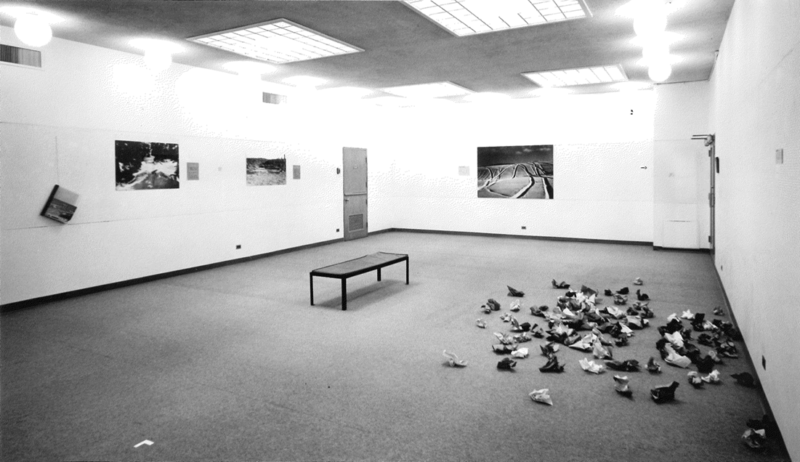
HANES: Could you tell me about some of the more memorable exhibitions you curated at the Richmond Art Center?
MARIONI: Every year, the Richmond Art Center would have a juried annual, which alternated between a Sculpture Annual and a Painting Annual. I got [renowned American painter] Wayne Thiebaud to jury the Painting Annual and Larry Bell to jury the Sculpture Annual. Larry Bell’s Sculpture Annual was a scandal because he only picked three artists and they were all conceptual artists: Terry Fox, Paul Kos, and James McCready. Everyone else was a “first prize winner” and got their $5 entry fee back. I got blamed for it, but it was all Larry Bell. I had no idea that he would select those works.
HANES: Terry Fox’s Levitation (1970) was also a bit of a scandal, right?
MARIONI: I first met Terry Fox when I included him in The Return of Abstract Expressionism. After that, I invited him to perform his famous Levitation piece at the Richmond Art Center. He covered the gallery floor with white paper and made a dirt island [in the center of the room]. He laid on the floor and tried to levitate. Fox had Hodgkin’s disease and the piece was related to his illness. The Director of Parks and Recreation forced that show to close after three days because he said it was obnoxious. He got the Health Department to say the dirt was a health hazard and the Fire Department to say the paper was a fire hazard.
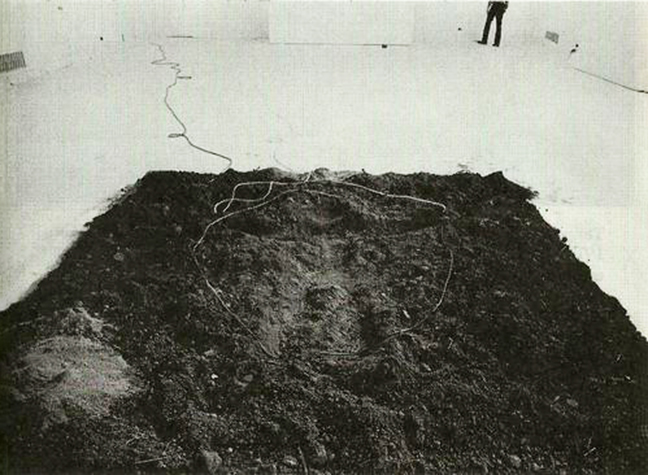
MARIONI: Another work that closed early was Paul Kos’s Richmond Glacier (1969). I met Paul Kos when he came to see Invisible Painting and Sculpture. He showed me his work and I invited him to have a solo show, which was titled Participation Kinetics (1969). Richmond Glacier was in that show. It consisted of 25-pound blocks of ice stacked to make a big [7,000 pound] sculpture that would have taken a few days to melt. It blocked the main entrance of the museum. Kos wanted viewers to go around the side of the museum to get into the gallery, but the city carted it away.
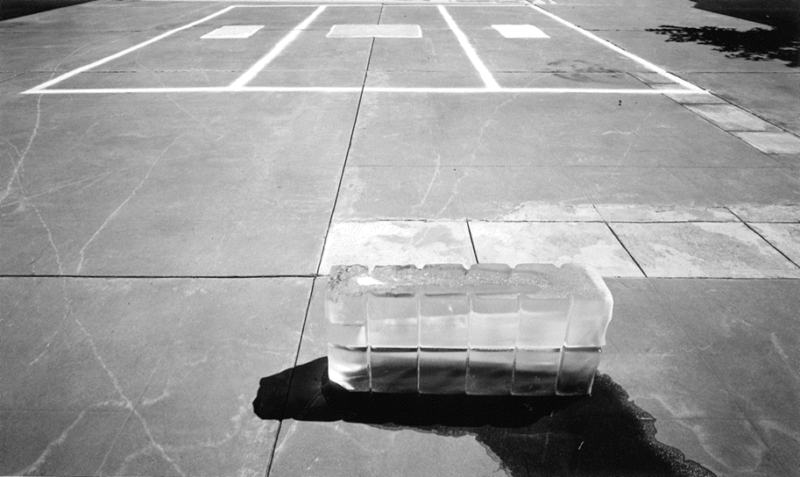
HANES: Are there any other moments or artworks that stand out in your memory from your time at the Richmond Art Center?
MARIONI: Before I applied to the job at the Richmond Art Center, I showed my sculptures to Hayward King, who was the director and curator at the time. He invited me to have a show. Then, about a month later, I interviewed for the curator’s job and they hired me. In the meantime, my show was already scheduled by Hayward King, so I installed it. When the exhibition was reviewed, a reporter claimed that the first thing I did as curator at the Richmond Art Center was to exhibit my own work, which wasn’t true. That was something I always regretted not being able to correct.
HANES: What was the last exhibition you curated at the Richmond Art Center?
MARIONI: The last show I curated was a group exhibition of women artists from L.A. and San Francisco. Janet Webb was an interesting conceptual artist in L.A., and she gave me the idea for the name for the show—California Girls, based on the Beach Boys song that was popular in the late 1960s. Liz King had a very interesting piece in the show. My favorite was Marsha Fox’s sculpture, which was a bra for a cow. It had big straps that went around the cow with a cup for each of the nipples. It was a really great hanging sculpture made out of cloth, like a [Claes] Oldenburg. I was friends with Judy Chicago and her husband, Lloyd Hamrol, at the time. Chicago was a prominent artist in L.A. who also taught feminist studio art classes at Fresno [State College]. The fact that she was a woman that didn’t keep her down any, because she was so strong. She was responsible for me getting fired from the Richmond Art Center. We weren’t friends after that, and I haven’t seen her since.
HANES: Was your relationship with Chicago and Hamrol what connected you to the feminist art movement and led to the California Girls exhibition?
MARIONI: Not really. I always thought that men become artists because they want to express their female side. I think most male artists are feminists. That’s what the premise of the show was. And I think it was probably one of the first feminist art shows in the country. I can’t say for sure, but I didn’t know of any other at the time.
HANES: Were all of the artists part of the feminist art movement or was the exhibition feminist because the works were political?
MARIONI: I didn’t think of it as a feminist art show at the time. I just thought of it as a show of women artists.
HANES: Can you tell me about the opening reception of California Girls and the piece that Judy Chicago sent her student [from the Fresno State College Feminist Art Program] to perform?
MARIONI: Ernie Kim was Head of Education [at the Richmond Art Center] and taught ceramics. He asked me what was going to happen at the opening, and I told him. Kim told the Director of Parks and Recreation, who never came to any of the openings of the shows I curated. The Director of Parks and Recreation came to California Girls and stayed until the end, when Judy Chicago’s student [Cheryl Zurilgen] performed. She wore a white, two-piece bathing suit and strapped a milking machine to herself. She laid a long strip of paper on the floor of the front hall. She crawled on her hands and knees and dragged cow’s blood on the paper. It was creepy. I got fired the next day.
HANES: Did they fire you because, similar to the Fox piece, there was blood in the gallery?
MARIONI: The Richmond Art Center had been trying to fire me since the Terry Fox show, but Hayward King wouldn’t do it. He always gave me a good review because I was putting the Richmond Art Center on the map. They fired him a year before I left, so I was in charge the last year I was there. As soon as I got fired, they made Ernie Kim acting director. It’s like he was after my job. It was a dirty trick.
HANES: I’m interested to hear about your approach to curating California Girls 2 in 2021. How does this presentation of artists relate to the original exhibition? Are you going to invite any of the original artists?
MARIONI: I don’t know any of the original artists anymore. It’s been 50 years and some of them have died or moved away. Liz King became a famous sculptor in West Virginia. Janet Webb lives in New Mexico. There’s no way to invite any of the original artists after this many years. The women I’m inviting to California Girls 2 are women artists that I know and admire.
HANES: Why is it important to reconsider California Girls from the current contemporary moment?
MARIONI: Two reasons: it’s the 50th anniversary of the original exhibition and there’s the #MeToo movement. Also, some of the most prominent artists today are women.
Shaelyn Hanes is a San Francisco-based curator, writer, and arts professional. She has supported curatorial projects at the CCA Wattis Institute for Contemporary Arts, Berkeley Art Museum and Pacific Film Archive, and di Rosa Center for Contemporary Art. Shaelyn earned an MA in Curatorial Practice at California College of the Arts in 2021 and a BA in Interdisciplinary Field Studies from the University of California, Berkeley in 2010. Her graduate thesis explores the role that women artists played in Tom Marioni’s Museum of Conceptual Art in the early 1970s.
CLICK HERE to view California Girls 2, an online exhibition curated by Tom Marioni.
Top image: Allan Fish (Tom Marioni), Birds in Flight, 1969. Courtesy of the Artist

